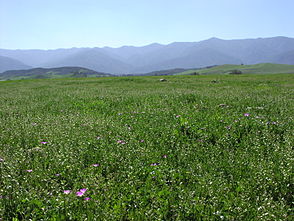Cuyama Valley
| Cuyama Valley | ||
|---|---|---|
|
In the Cuyama Valley with a southward view of the Sierra Madre |
||
| location | California , United States | |
| Waters | Cuyama River | |
| Geographical location | 35 ° 1 '54 " N , 119 ° 52' 35" W | |
|
|
||
| Type | landmark | |
| height | 800 to 600 m | |
The Cuyama Valley is a valley on the Cuyama River in central California in northern Santa Barbara County , southern San Luis Obispo County , southwestern Kern County, and northwestern Ventura County . It is a rather sparsely populated area with two distinct cities - Cuyama and New Cuyama - that is largely used for cattle breeding, arable farming, and crude oil and natural gas production. California State Route 166 runs almost the entire length of the valley and connects the coastal towns of Santa Maria and Arroyo Grande with the California long valley at Bakersfield .
geography
The valley covers an area of around 300 square kilometers, which is framed on all sides by mountains. The Cuyama River drains the valley through a narrow canyon between the Sierra Madre Mountains in the south and the La Panza Range in the north. From its headwaters north of California State Route 33 , the valley widens to its greatest width. This is roughly where routes 166 and 33 intersect and meet the borders of the four counties that share in the valley. Then the valley narrows again until the river disappears between the mountain ranges on its way to the ocean. The agriculturally used parts are largely in the middle, where the valley is a broad alluvial plain.
To the north of the valley lies the approximately 1500 meter high Caliente Range , opposite is the Carrizo Plain . In the east and south-east lies the high hinterland of Ventura County, which includes Mount Pinos as the highest peak in the region. The extreme northeast of the valley lies on the San Andreas Fault , which forms a low collection of hills here, over the route 166; behind it are the southern San Joaquin Valley and Bakersfield . The Los Padres National Forest is bordered by the Cuyama Valley to the south, east, and northeast; most of the land in the north, including much of the Caliente Range, is owned by the Bureau of Land Management .
Geologically, the valley is an alluvial- filled syncline that lies between 600 and 800 meters above sea level. The rock is mostly sedimentary and from the Miocene originating Monterey formation is pending in the south in the foothills of the Sierra Madre. There are also formations from the Pliocene and Pleistocene . The Morales Fault separates the valley from the Caliente Range, which rises abruptly in the north. The upper part of the valley, north and northeast of the Pine Mountains, consists of badlands .
The climate is semi-arid with hot summers and cool winters. Almost all precipitation falls in the form of rain during the winter months, although snow does occur occasionally. The annual rainfall is about 100 mm, which makes the valley floor one of the driest areas in the coastal area of central California, although the valley is open to the sea and is therefore occasionally exposed to maritime influences. The predominant original vegetation of the valley is grassland and scrub, chaparral and oak forests grow on the hills in the south.
history
The original inhabitants of the valley were Indians from the Chumash tribe . The first European settlers arrived at the beginning of the 19th century and towards the end of the Mexican period the valley was divided into two land development areas. The primary land use was grazing by cattle, although in the late 19th century there was isolated agriculture in side valleys where there was more water. In 1939, the first successful drilling for the deep groundwater was carried out and the valley was transformed into an agricultural area through irrigation.
Economic development was slow until 1948 when petroleum was found on the Russel Ranch . A year later, the South Cuyama oil field was developed. The Richfield Oil Company, later part of the Atlantic Richfield Company , built the town of New Cuyama to house its workers and the services that were designated for them. The recovered oil was pumped through a pipeline to a refinery in Long Beach. In the early 1950s, the Cuyama Valley ranked fourth in California in terms of crude oil production.
When oil production declined - it is estimated that only two percent of the South Cuyama oil field's supplies remain - agriculture once again became the main activity in the valley. The sharp rise in crude oil prices in 2007 and 2008, however, rekindled interest and E&B Natural Resources acquired the production rights to the Hallador Petroleum field.
swell
- Charles W. Jennings and Rudolph G. Strand. Geologic Map of California . Los Angeles sheet. State of California, Division of Mines and Geology. 1969.
- Dennis W. Lantis, Rodney Steiner, Arthur E. Karinen: California, Land of Contrast , 3rd edition. Kendall / Hunt Publishing Company, Dubuque Iowa. 1977. ISBN 0-8403-0768-3 . Pages 193-194.
Individual evidence
- ↑ California Department of Conservation, Oil and Gas Statistics, Annual Report, December 31, 2006 , p. 67 (PDF, English)


